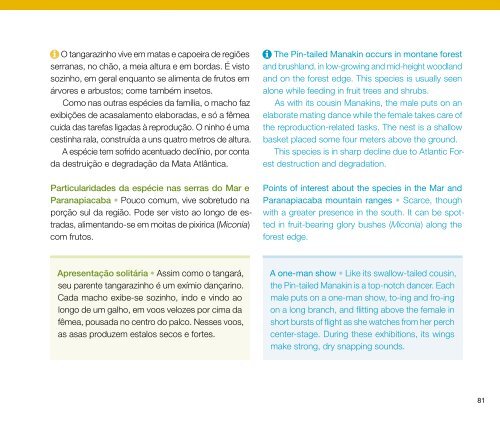Guia de aves Mata Atlântica Paulista - Secretaria do Meio Ambiente
Guia de aves Mata Atlântica Paulista - Secretaria do Meio Ambiente
Guia de aves Mata Atlântica Paulista - Secretaria do Meio Ambiente
Create successful ePaper yourself
Turn your PDF publications into a flip-book with our unique Google optimized e-Paper software.
O tangarazinho vive em matas e capoeira <strong>de</strong> re giões<br />
serranas, no chão, a meia altura e em bordas. É visto<br />
sozinho, em geral enquanto se alimenta <strong>de</strong> frutos em<br />
árvores e arbustos; come também insetos.<br />
Como nas outras espécies da família, o macho faz<br />
exibições <strong>de</strong> acasalamento elaboradas, e só a fêmea<br />
cuida das tarefas ligadas à reprodução. O ninho é uma<br />
cestinha rala, construída a uns quatro metros <strong>de</strong> altura.<br />
A espécie tem sofri<strong>do</strong> acentua<strong>do</strong> <strong>de</strong>clínio, por conta<br />
da <strong>de</strong>struição e <strong>de</strong>gradação da <strong>Mata</strong> <strong>Atlântica</strong>.<br />
Particularida<strong>de</strong>s da espécie nas serras <strong>do</strong> Mar e<br />
Paranapiacaba • Pouco comum, vive sobretu<strong>do</strong> na<br />
porção sul da região. Po<strong>de</strong> ser visto ao longo <strong>de</strong> estradas,<br />
alimentan<strong>do</strong>-se em moitas <strong>de</strong> pixirica (Miconia)<br />
com frutos.<br />
The Pin-tailed Manakin occurs in montane forest<br />
and brushland, in low-growing and mid-height woodland<br />
and on the forest edge. This species is usually seen<br />
alone while feeding in fruit trees and shrubs.<br />
As with its cousin Manakins, the male puts on an<br />
elaborate mating dance while the female takes care of<br />
the reproduction-related tasks. The nest is a shallow<br />
basket placed some four meters above the ground.<br />
This species is in sharp <strong>de</strong>cline due to Atlantic Forest<br />
<strong>de</strong>struction and <strong>de</strong>gradation.<br />
Points of interest about the species in the Mar and<br />
Paranapiacaba mountain ranges • scarce, though<br />
with a greater presence in the south. It can be spotted<br />
in fruit-bearing glory bushes (Miconia) along the<br />
forest edge.<br />
Apresentação solitária • Assim como o tangará,<br />
seu parente tangarazinho é um exímio dançarino.<br />
Cada macho exibe-se sozinho, in<strong>do</strong> e vin<strong>do</strong> ao<br />
longo <strong>de</strong> um galho, em voos velozes por cima da<br />
fêmea, pousada no centro <strong>do</strong> palco. Nesses voos,<br />
as asas produzem estalos secos e fortes.<br />
A one-man show • Like its swallow-tailed cousin,<br />
the Pin-tailed Manakin is a top-notch dancer. Each<br />
male puts on a one-man show, to-ing and fro-ing<br />
on a long branch, and flitting above the female in<br />
short bursts of flight as she watches from her perch<br />
center-stage. During these exhibitions, its wings<br />
make strong, dry snapping sounds.<br />
81

















